Bīrūnī, Muḥammad ibn Aḥmad, Alberuni's India (v. 1)
(London : Kegan Paul, Trench, Trübner & Co., 1910.)
|
||
|
|
|
|
| Page 270 |

270 ALBERUNPS INDIA. firma and the ocean. For in certain places the con¬ tinent protrudes far into the ocean, so as to pass beyond the equator, e.g. the plains of the negroes in the west, which protrude far towards the south, even beyond the mountctins of the moon and the sources of the Nile, in fact, into regions which we do not exactly know. For that continent is desert and impassable, and likewise the sea behind Sufala of the Zanj is unnavigable. No ship which ventured to go there has ever returned to relate what it had witnessed. Also a great part of India above the province of Sindh deeply protrudes far towards the south, and seems even to pass beyond the equator. In the midst between both lie Arabia and Yemen, but they do not go so far south as to cross the equator. Further, as the terra firma stretches far out into the ocean, thus the ocean too penetrates into terra firma, breaking into it in various places, and forming bays and gulfs. For instance, the sea extends as a tongue along the west side of Arabia as far as the neighbour¬ hood of Central Syria. It is narrowest near Kulzum, whence it is also called the Sect of Kulzum. Another and still larger arm of the sea exists east of Arabia, the so-called Persian Sea. Between India and China, also, the sea forms a great curve towards the north. Hence it is evident that the coast-line of these countries does not correspond to the equator, nor keep an invariable distance from it, (Lactma,) and the explanation relating to the four cities will follow in its proper place. The difference of the times which has been remarked is one of the results of the rotundity of the earth, and of its occupying the centre of the globe. And if they attribute to the earth, though it be round, inhabitants— for cities cannot be imagined without inhabitants—the existence of men on earth is accounted for by the |
| Page 270 |







